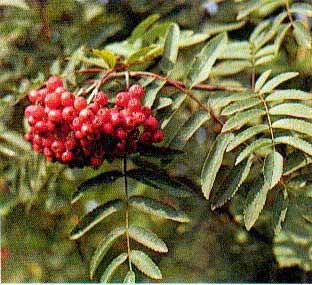BACK TO


Synynoms
Mountain Ash, Gaelic Caorunn, Welsh Cerddin, Irish Caorthann (family Rosaceae)
'Rowan' is derived from a Norse word 'runa' meaning a charm. Hence it was often planted outside houses, to ward off witches.
Description:
Small vigorous hardy deciduous tree producing large number of red berries in autumn. Coppices well. Height 15m but up to 18m. Age 100 years or more Rowan is pyramidal in outline, with a smooth, shiny, grey bark. It is found in woods, scrub and on mountains, on acid soils. It grows to almost 1000 m above sea level, higher than any other British tree.
Leaves
The pinnate leaves are alternate, and have 6-8 pairs of single- or double-toothed, stalkless leaflets which are 3-6 cm long: the terminal leaflet is never larger than the rest. The leaflets are usually hairless, except beneath on the midrib, when young. The leaf-stalks are 2-4 cm long.

Fruits
The almost round, fleshy red berries, 6-9 mm long, are yellow at first, but red when ripe in September. Each has 1-2 seeds inside

The creamy-white 5-petalled flowers, 6-9 mm across, are arranged in flat, branched clusters about 10 cm wide.
Location
Light and peaty soils not water logged up to 1000m. Pioneer species not tolerant of shading except in some Scots Pine woods. Commonest West and North of Britain but native throughout Britain and Ireland. Also Europe, North Africa and Asia Minor.
Phenology:
Flowers Leaves Fruit Ripen Fall
May/June April Sept Oct/Nov
Similar species:
Other Sorbus species.
Uses
Dense hard pale brown wood. Uses of wood - Turnery and carving and good firewood. Used to make bows in middleages. Formerly used for tool handles, mallet heads, bowls and platters. Food and drink - Berries are edible and used to make rowan jelly which is eaten with game. Enjoyed by birds who disperse seed.The berries make a fine jelly good to eat with game.The berries are relished by larger birds in winter especially thrushes and their relatives
Growth & Propagation
Grown from seed. Treat as per Whitebeam. Approx 200,000 seeds per kg.